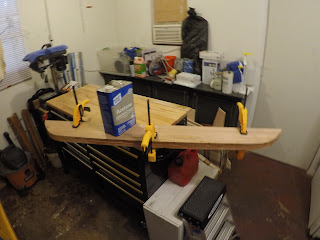I can hardly believe that it has been 1 1/2 years since my
last post. many updates to post. First I have been officially retired now for a
month and am just getting used to waking to a long morning coffee with no need
to hurry off to work. Motivation is slow to emerge but is coming daily in small
spurts and that includes my work on boats.
I have changed my tack once again in my intention with
boats. I came across a 1978 Laguna Windrose 18, the same boat I took to Kansas
with me, the boat I should never have let go of. Well, I had a second chance so
I bought it in February of this year, 2017. This boat though has a retractable
keel. This will allow me to go into shallow bayous (or sloughs depending on
which State I am in). And the 18 foot with a cabin will suit me at this stage
of the sailing game. I can handle it easy enough. It could be sailed straight
away but as with most things, I want to bring it back to excellent condition so
have set it aside for the time being. Time I now have and never really acknowledging
deadlines in my life, I am not bothered by how long it may take.
I have gutted the electrics as they were so far out of date.
It also had a mechanical Knott meter and depth transponder that I will
completely remove. I have a handheld Garmin GPS unit, Oregon 650, which will do
just fine for the inland lakes and deltas that I plan to sail. The boat weighs
about a ton so my 2005 Porsche Cayenne pulls it without any problems.
The Other two boats have gone without further work. I sold
each to coworkers for a bottle of spirits, one Scotch and one Irish Whiskey.
One came back to me as the family that had it decided to get a larger ski boat
so I sent that one to my son in Northern California. It suffered some damage in
the transport so he sold it off to another sailor with a Lido 14 for parts
& trailer.
So I am now in possession of the Windrose and had planned to
devote my immediate retirement energies to restoring it. BUT........as usual,
another boat entered the scheme of things. A friend had a 12 foot aluminum row
boat that had been sitting, upside down, in the yard for 13 plus years and all
the wood (gunnels, seats & transom) had rotted away. So I agreed to take it
on as a project of restoration.
I removed all the wood, excess rivets and am in the process
of removing the paint. 2 applications of stripper and there is still a layer,
or two, clinging to the floor. So I am using a grinder with a 4" wire
brush cup to clean the inside. It is pretty tough going but the results are so
good, I am motivated to continue. Once the boat is cleaned, we will need some
professional welding done to the outside. I have tried MAPP Gas/Oxygen & Acetylene/Oxygen
but to no avail. Time for a Professional Welder.
Then I will fit the wood and we should be good to go.
As far as the Windrose goes, I am going to take it to Lake
Pleasant Sailboat Shop yard (North of Phoenix, AZ) to lift it off the trailer
so as to drop the keel. I want to clean it and repaint it. Other than a few
repairs (the bulkhead inside the cabin that supports the mast has a small part
rotted out and must be replaced), I hope to have it in the water in the spring
of 2018.
In the meantime I am still playing music and am part of a
trio these days. We have taken the rest of the year off but are still
rehearsing some and hope to book gigs for next spring!
https://www.youtube.com/watch?v=jUQ6y9zOOtc
Happy Halloween 2017!!














































